- REDIRECTTemplate:Test3
Response to "For my Wife and Children" ("Letter to my Wife"): Chapter 2 - The Translation (Book of Mormon)
Response to claims made in "For my Wife and Children" ("Letter to my Wife"): Chapter 2 - The Translation (Book of Mormon)
Jump to details:
Response to claim: "David Whitmer mentions a seer stone, but other than this more than 20 year-old Ensign article, the existence of this method using a stone in a hat has never been mentioned"
The author(s) of "For my Wife and Children" ("Letter to my Wife") make(s) the following claim:
David Whitmer mentions a seer stone, but other than this more than 20 year-old Ensign article, the existence of this method using a stone in a hat has never been mentioned. In December, 2013 the Church released an essay addressing the translation of the Book of Mormon. Finally the seer stone is again mentioned for a new generation of members.
FAIR's Response
Fact checking results: The author has stated erroneous information or misinterpreted their sources
The stone, and sometimes the hat, have been mentioned, although infrequently, at other times in Church publications in addition to the July 1993 mention by Russell M. Nelson.
- In 2005, Opening the Heavens was published jointly by the Joseph Fielding Smith Institute for Latter-day Saint History and Deseret Book. As part of this book, at least twenty-nine references to the stone (often with the hat) are included, from both friendly and hostile sources: p. 112, 129, 130, 135, 136, 137, 138, 142, 146, 148, 149, 150, 151, 152, 153, 154, 155, 156, 157, 158, 164, 166, 168, 178, 184, 185, 187, 192, 193, 196.
- January 1997 Ensign: "Martin Harris related of the seer stone: 'Sentences would appear and were read by the Prophet and written by Martin.'" [1]
- July 1993 Ensign: (the quote mentioned by the author): "David Whitmer wrote: 'Joseph Smith would put the seer stone into a hat, and put his face in the hat, drawing it closely around his face to exclude the light; and in the darkness the spiritual light would shine.'" [2]
- 1988 book by Neal A. Maxwell, Not My Will, But Thine: "Jacob censured the "stiffnecked" Jews for "looking beyond the mark" (Jacob 4:14). We are looking beyond the mark today, for example, if we are more interested in the physical dimensions of the cross than in what Jesus achieved thereon; or when we neglect Alma's words on faith because we are too fascinated by the light-shielding hat reportedly used by Joseph Smith during some of the translating of the Book of Mormon. To neglect substance while focusing on process is another form of unsubmissively looking beyond the mark." [3]
- January 1988 Ensign: "Once Martin found a rock closely resembling the seerstone Joseph sometimes used in place of the interpreters and substituted it without the Prophet’s knowledge. When the translation resumed, Joseph paused for a long time and then exclaimed, “Martin, what is the matter, all is as dark as Egypt.” Martin then confessed that he wished to “stop the mouths of fools” who told him that the Prophet memorized sentences and merely repeated them."[4]
- September 1977 Ensign: There he gave his most detailed view of 'the manner in which the Book of Mormon was translated: 'Joseph Smith would put the seer stone into a hat and put his face in the hat, drawing it closely around his face to exclude the light.'"[5]
- September 1974 Friend: "To help him with the translation, Joseph found with the gold plates 'a curious instrument which the ancients called Urim and Thummim, which consisted of two transparent stones set in a rim of a bow fastened to a breastplate.' Joseph also used an egg-shaped, brown rock for translating called a seer stone."[6]
Question: What Church sources discuss either the use of the seer stone or the stone and the hat as part of the Book of Mormon translation process?
The manner of the translation is described repeatedly, for example, in the Church's official magazine for English-speaking adults, the Ensign. Richard Lloyd Anderson discussed the "stone in the hat" matter in 1977,[7] and Elder Russell M. Nelson quoted David Whitmer's account to new mission presidents in 1992.[8]
The details of the translation are not certain, and the witnesses do not all agree in every particular. However, Joseph's seer stone in the hat was also discussed by, among others: B.H. Roberts in his New Witnesses for God (1895)[9] and returns somewhat to the matter in Comprehensive History of the Church (1912).[10] Other Church sources to discuss this include The Improvement Era (1939),[11] BYU Studies (1984, 1990)[12] the Journal of Book of Mormon Studies (1993),[13] and the FARMS Review (1994).[14] LDS authors Joseph Fielding McConkie and Craig J. Ostler also mentioned the matter in 2000.[15] Elder Bruce R. McConkie talked about the seer stone in his second edition of Mormon Doctrine (1966), clearly distinguishing it from the Urim and Thummim, loosely implying that it was involved in the translation of the Book of Mormon, and quoting President Joseph Fielding Smith who said that "[t]his seer stone is now in the possession of the Church."[16]
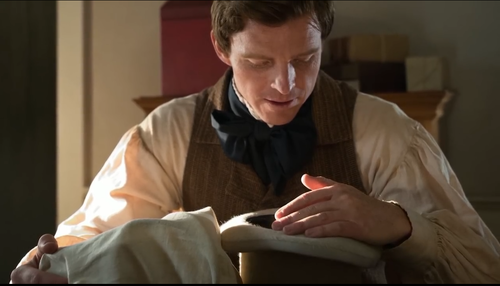
Image from video "Seer Stones and the Translation of the Book of Mormon," The Church of Jesus Christ of Latter-day Saints. Copyright (c) 2015 Intellectual Reserve
2016
Translation display at the Church-owned Priesthood Restoration site in Pennsylvania
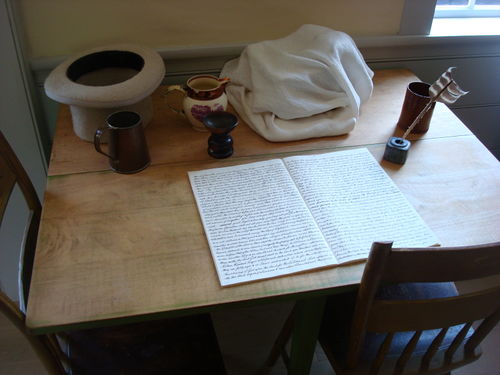
A translation display at the Church-owned Priesthood Restoration historical site in Pennsylvania showing the hat, the plates (covered with a cloth) and writing instruments
2015
"Joseph the Seer," Ensign (October 2015)
In fact, historical evidence shows that in addition to the two seer stones known as “interpreters,” Joseph Smith used at least one other seer stone in translating the Book of Mormon, often placing it into a hat in order to block out light. According to Joseph’s contemporaries, he did this in order to better view the words on the stone.
—Richard E. Turley Jr., Robin S. Jensen and Mark Ashurst-McGee, "Joseph the Seer," Ensign (October 2015)
The stone pictured here has long been associated with Joseph Smith and the Book of Mormon translation. The stone Joseph Smith used in the Book of Mormon translation effort was often referred to as a chocolate-colored stone with an oval shape. This stone passed from Joseph Smith to Oliver Cowdery and then to the Church through Brigham Young and others.
—Richard E. Turley Jr., Robin S. Jensen and Mark Ashurst-McGee, "Joseph the Seer," Ensign (October 2015)
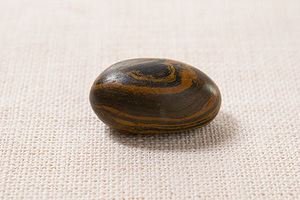
A picture of Joseph Smith's seer stone from the October 2015
Ensign. Photograph by Welden C. Andersen and Richard E. Turley Jr.
From Darkness Unto Light: Joseph Smith's Translation and Publication of the Book of Mormon, Religious Studies Center, BYU, Deseret Book Company (May 11, 2015)
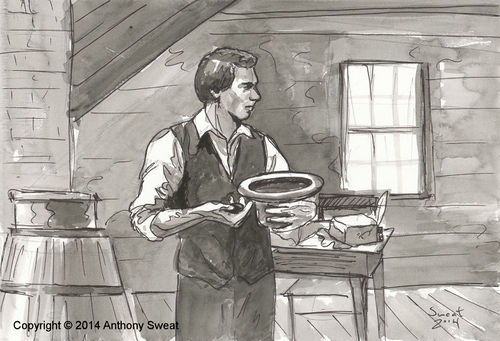
Joseph Smith prepares to translate using the seer stone placed within his hat while the plates are wrapped on the table. Image Copyright (c) 2014 Anthony Sweat. This image appears in the Church publication
From Darkness Unto Light: Joseph Smith's Translation and Publication of the Book of Mormon, by Michael Hubbard Mackay and Gerrit J. Dirkmaat, Religious Studies Center, BYU, Deseret Book Company (May 11, 2015)
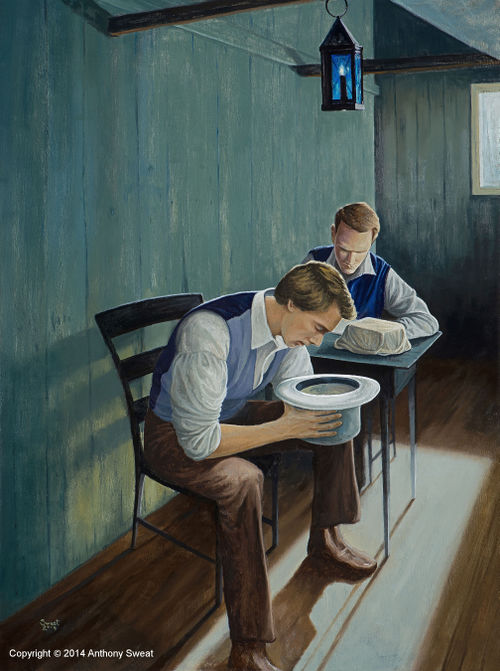
Joseph Smith prepares to translate using the seer stone placed within his hat while Oliver Cowdery acts as scribe. Image Copyright (c) 2014 Anthony Sweat. This image appears in the Church publication
From Darkness Unto Light: Joseph Smith's Translation and Publication of the Book of Mormon, by Michael Hubbard Mackay and Gerrit J. Dirkmaat, Religious Studies Center, BYU, Deseret Book Company (May 11, 2015)
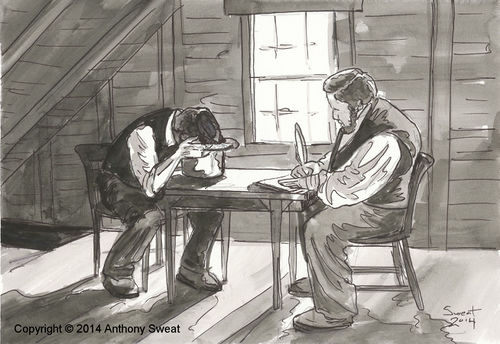
Joseph Smith translates using the seer stone placed within his hat while Martin Harris acts as scribe. Image Copyright (c) 2014 Anthony Sweat. This image appears in the Church publication
From Darkness Unto Light: Joseph Smith's Translation and Publication of the Book of Mormon, by Michael Hubbard Mackay and Gerrit J. Dirkmaat, Religious Studies Center, BYU, Deseret Book Company (May 11, 2015)
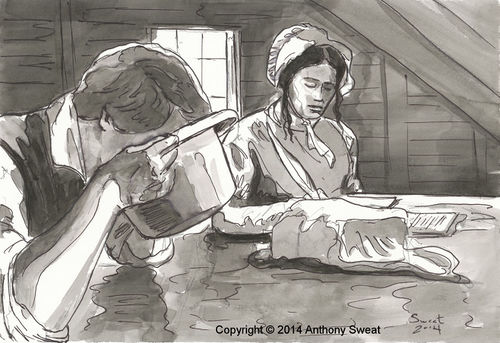
Joseph Smith translates using the seer stone placed within his hat while Emma Smith acts as scribe. Image Copyright (c) 2014 Anthony Sweat. This image appears in the Church publication
From Darkness Unto Light: Joseph Smith's Translation and Publication of the Book of Mormon, by Michael Hubbard Mackay and Gerrit J. Dirkmaat, Religious Studies Center, BYU, Deseret Book Company (May 11, 2015)
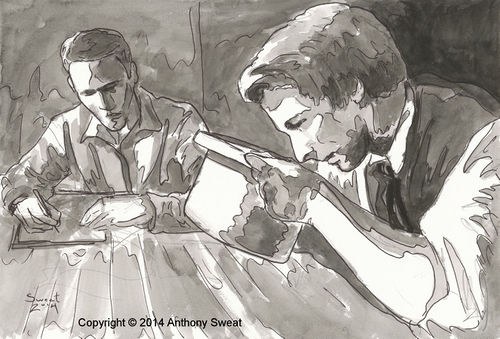
Joseph Smith translates using the seer stone placed within his hat while Oliver Cowdery acts as scribe. Image Copyright (c) 2014 Anthony Sweat. This image appears in the Church publication
From Darkness Unto Light: Joseph Smith's Translation and Publication of the Book of Mormon, by Michael Hubbard Mackay and Gerrit J. Dirkmaat, Religious Studies Center, BYU, Deseret Book Company (May 11, 2015)
2013
Doctrine and Covenants and Church History Seminary Teacher Manual, 2013
The Urim and Thummim was “an instrument prepared of God to assist man in obtaining revelation from the Lord and in translating languages” (Bible Dictionary, “Urim and Thummim”). Joseph Smith used the Urim and Thummim to aid in the translation of the Book of Mormon. In addition to the Urim and Thummim, the Prophet used a seer stone in the translation process.
Elder Neal A. Maxwell of the Quorum of the Twelve Apostles said the following about the translation process and Joseph Smith’s use of the Urim and Thummim and the seer stone:
“The Prophet Joseph alone knew the full process, and he was deliberately reluctant to describe details. We take passing notice of the words of David Whitmer, Joseph Knight, and Martin Harris, who were observers, not translators. David Whitmer indicated that as the Prophet used the divine instrumentalities provided to help him, ‘the hieroglyphics would appear, and also the translation in the English language … in bright luminous letters.’ Then Joseph would read the words to Oliver (quoted in James H. Hart, “About the Book of Mormon,” Deseret Evening News, 25 Mar. 1884, 2). Martin Harris related of the seer stone: ‘Sentences would appear and were read by the Prophet and written by Martin’ (quoted in Edward Stevenson, “One of the Three Witnesses: Incidents in the Life of Martin Harris,” Latter-day Saints’ Millennial Star, 6 Feb. 1882, 86–87). Joseph Knight made similar observations (see Dean Jessee, “Joseph Knight’s Recollection of Early Mormon History,” BYU Studies 17 [Autumn 1976]: 35).
"Lesson 10: Joseph Smith—History 1:55–65," Doctrine and Covenants and Church History Seminary Teacher Manual, 2013 (available online at LDS.org)
"Book of Mormon Translation," Gospel Topics on lds.org
Two accounts of the translation process, including the use of a seer stone, have been written by members of the Quorum of the Twelve Apostles and published in Church magazines. Historians have also written about the seer stone in Church publications, both in the Ensign and in The Joseph Smith Papers. (See Neal A. Maxwell, “‘By the Gift and Power of God,’” Ensign, Jan. 1997, 36–41; Russell M. Nelson, “A Treasured Testament,” Ensign, July 1993, 61–63; Richard Lloyd Anderson, “‘By the Gift and Power of God,’” Ensign, Sept. 1977, 78–85; and Documents, Volume 1: July 1828–June 1831, xxix–xxxii.)
—"Book of Mormon Translation," Gospel Topics on lds.org off-site
Ensign
Gerrit Dirkmaat (Church History Department - January 2013 Ensign):
Those who believed that Joseph Smith’s revelations contained the voice of the Lord speaking to them also accepted the miraculous ways in which the revelations were received. Some of the Prophet Joseph’s earliest revelations came through the same means by which he translated the Book of Mormon from the gold plates. In the stone box containing the gold plates, Joseph found what Book of Mormon prophets referred to as “interpreters,” or a “stone, which shall shine forth in darkness unto light” (Alma 37:23–24). He described the instrument as “spectacles” and referred to it using an Old Testament term, Urim and Thummim (see Exodus 28:30).2
He also sometimes applied the term to other stones he possessed, called “seer stones” because they aided him in receiving revelations as a seer. The Prophet received some early revelations through the use of these seer stones. For example, shortly after Oliver Cowdery came to serve as a scribe for Joseph Smith as he translated the plates, Oliver and Joseph debated the meaning of a biblical passage and sought an answer through revelation. Joseph explained: “A difference of opinion arising between us about the account of John the Apostle … whether he died, or whether he continued; we mutually agreed to settle it by the Urim and Thummim.”3 In response, Joseph Smith received the revelation now known as section 7 of the Doctrine and Covenants, which informed them that Jesus had told the Apostle John, “Thou shalt tarry until I come in my glory” (D&C 7:3).
Records indicate that soon after the founding of the Church in 1830, the Prophet stopped using the seer stones as a regular means of receiving revelations. Instead, he dictated the revelations after inquiring of the Lord without employing an external instrument. One of his scribes explained that process: “The scribe seats himself at a desk or table, with pen, ink, and paper. The subject of inquiry being understood, the Prophet and Revelator inquires of God. He spiritually sees, hears, and feels, and then speaks as he is moved upon by the Holy Ghost.”
Gerrit Dirkmaat (Church History Department), "Great and Marvelous Are the Revelations of God," Ensign, January 2013. (emphasis added) off-site
2005
In 2005, Opening the Heavens was published jointly by the Joseph Fielding Smith Institute for Latter-day Saint History and Deseret Book. As part of this book, at least twenty-nine references to the stone (often with the hat) are included, from both friendly and hostile sources:
- p. 112, 129, 130, 135, 136, 137, 138, 142, 146, 148, 149, 150, 151, 152, 153, 154, 155, 156, 157, 158, 164, 166, 168, 178, 184, 185, 187, 192, 193, 196.
1997
Ensign
"Martin Harris related of the seer stone: 'Sentences would appear and were read by the Prophet and written by Martin'"
—Neal A. Maxwell, “‘By the Gift and Power of God’,” Ensign, January 1997, 36 (emphasis added) off-site
1993
Ensign
"David Whitmer wrote: ' Joseph Smith would put the seer stone into a hat, and put his face in the hat, drawing it closely around his face to exclude the light; and in the darkness the spiritual light would shine.'"
—Russell M. Nelson, “A Treasured Testament,” Ensign, Jul 1993, 61. (emphasis added) off-site
1988
Not My Will, But Thine
"Jacob censured the "stiffnecked" Jews for "looking beyond the mark" (Jacob 4:14). We are looking beyond the mark today, for example, if we are more interested in the physical dimensions of the cross than in what Jesus achieved thereon; or when we neglect Alma's words on faith because we are too fascinated by the light-shielding hat reportedly used by Joseph Smith during some of the translating of the Book of Mormon. To neglect substance while focusing on process is another form of unsubmissively looking beyond the mark."
—Neal A. Maxwell, Not My Will, But Thine (Salt Lake City, Utah: Bookcraft, 1988), 26.
Ensign
The scriptures indicate that translation involved sight, power, transcription of the characters, the Urim and Thummim or a seerstone, study, and prayer.
After returning from a trip to Palmyra to settle his affairs, Martin began to transcribe. From April 12 to June 14, Joseph translated while Martin wrote, with only a curtain between them. On occasion they took breaks from the arduous task, sometimes going to the river and throwing stones. Once Martin found a rock closely resembling the seerstone Joseph sometimes used in place of the interpreters and substituted it without the Prophet’s knowledge. When the translation resumed, Joseph paused for a long time and then exclaimed, “Martin, what is the matter, all is as dark as Egypt.” Martin then confessed that he wished to “stop the mouths of fools” who told him that the Prophet memorized sentences and merely repeated them." —Kenneth W. Godfrey, "A New Prophet and a New Scripture: The Coming Forth of the Book of Mormon," Ensign (Jan 1988).
1977
Ensign
"There he gave his most detailed view of 'the manner in which the Book of Mormon was translated': “Joseph Smith would put the seer stone into a hat and put his face in the hat, drawing it closely around his face to exclude the light."
—Richard Lloyd Anderson, "‘By the Gift and Power of God’," Ensign (Sep 1977): 79, emphasis added. off-site
1974
Friend
"To help him with the translation, Joseph found with the gold plates “a curious instrument which the ancients called Urim and Thummim, which consisted of two transparent stones set in a rim of a bow fastened to a breastplate.” Joseph also used an egg-shaped, brown rock for translating called a seer stone."
—“A Peaceful Heart,” Friend, Sep 1974, 7 off-site
1882
- Millennial Star 4 (1882).
Others
- Hyrum Andrus and Helen Mae Andrus, Personal Glimpses of the Prophet Joseph Smith (Covenant, 2009), 26, 44.
- Hyrum Andrus, Joseph Smith, the Man and the Seer (Deseret Book, 1960), 12, 101.
Response to claim: Joseph Smith was "taken to court for defrauding those he promised fortunes"
The author(s) of "For my Wife and Children" ("Letter to my Wife") make(s) the following claim:
Joseph Smith was "taken to court for defrauding those he promised fortunes"
FAIR's Response
Fact checking results: This claim contains propaganda - The author, or the author's source, is providing information or ideas in a slanted way in order to instill a particular attitude or response in the reader
There is no record of Joseph having "promised fortunes" to anyone: The author appears to have added his own speculation. Joseph did indeed appear in appear before a judge in 1826 in South Bainbridge at the behest of relatives of Josiah Stowell, whom they believed that Joseph was defrauding. The charges were that Joseph was a "disorderly person." However, Stowell defended Joseph, and Joseph was ultimately released without being fined or found guilty of any crime.
- REDIRECTJoseph Smith's 1826 trial#What is Joseph Smith's 1826 South Bainbridge "trial" for "glasslooking"?
- REDIRECTJoseph Smith's 1826 trial#What events resulted in Joseph Smith's 1826 court appearance in South Bainbridge?
Response to claim: "Josephsmithpapers.org displays one of the trial bills for Joseph’s court hearings in Bainbridge, New York where he was charged for fraud, a misdemeanor in 1826"
The author(s) of "For my Wife and Children" ("Letter to my Wife") make(s) the following claim:
Josephsmithpapers.org displays one of the trial bills for Joseph’s court hearings in Bainbridge, New York where he was charged for fraud, a misdemeanor in 1826.
FAIR's Response
Fact checking results: This claim contains propaganda - The author, or the author's source, is providing information or ideas in a slanted way in order to instill a particular attitude or response in the reader
Joseph was accused of fraud, but not convicted. The "trial bills" were to cover court costs: There was no fine issued. Noting that this was a "misdemeanor" is irrelevant and is included simply to bias the reader, since Joseph was never found guilty.
- REDIRECTJoseph Smith's 1826 trial#Why was Joseph fined if he wasn't found guilty of anything?
Response to claim: "Members have always been taught that Joseph’s times in court were because Satan was stirring up the hearts of those who would stop Joseph from the Lord’s work"
The author(s) of "For my Wife and Children" ("Letter to my Wife") make(s) the following claim:
Members have always been taught that Joseph’s times in court were because Satan was stirring up the hearts of those who would stop Joseph from the Lord’s work
FAIR's Response
Fact checking results: This claim contains propaganda - The author, or the author's source, is providing information or ideas in a slanted way in order to instill a particular attitude or response in the reader
In general, the Church teaches that Satan wished to stop the work of the Lord. However, the mention of Joseph Smith's 1826 court appearance in the June 1994
Ensign says nothing about "Satan" being responsible.
- REDIRECTJoseph Smith's 1826 trial#''Ensign'' (June 1994): "'''Highlights in the Prophet’s Life''' 20 Mar. 1826: Tried and acquitted on fanciful charge of being a "disorderly person," South Bainbridge, Chenango County, New York
Response to claim: "Joseph was using the same tool to defraud people as he later used to write the Book of Mormon"
The author(s) of "For my Wife and Children" ("Letter to my Wife") make(s) the following claim:
Joseph was using the same tool to defraud people as he later used to write the Book of Mormon
FAIR's Response
Fact checking results: This claim contains propaganda - The author, or the author's source, is providing information or ideas in a slanted way in order to instill a particular attitude or response in the reader
The author simply assumes that because Joseph used the stone to help people find things, that he was defrauding people."
Logical Fallacy: Begging the Question—The author presents a circular argument in which the starting assumption requires the conclusion to be true.
The author assumes that Joseph was defrauding people and then moves forward from that initial assumption.
Response to claim: "He used a seer stone to sell treasure hunting services and when that didn’t turn out well for him, he used the same stone to sell religious services"
The author(s) of "For my Wife and Children" ("Letter to my Wife") make(s) the following claim:
He used a seer stone to sell treasure hunting services and when that didn’t turn out well for him, he used the same stone to sell religious services
FAIR's Response
Fact checking results: This claim is false
The author presents no evidence that Joseph ever used his seer stone to "sell religious services"
Notes
- ↑ Neal A. Maxwell, “‘By the Gift and Power of God’,” Ensign, January 1997, 36.
off-site
- ↑ Russell M. Nelson, “A Treasured Testament,” Ensign, Jul 1993, 61. off-site
- ↑ Neal A. Maxwell, Not My Will, But Thine (Salt Lake City, Utah: Bookcraft, 1988), 26.
- ↑ Kenneth W. Godfrey, "A New Prophet and a New Scripture: The Coming Forth of the Book of Mormon," Ensign (Jan 1988).
- ↑ Richard Lloyd Anderson, "‘By the Gift and Power of God’," Ensign (Sep 1977): 79, emphasis added. off-site
- ↑ “A Peaceful Heart,” Friend, Sep 1974, 7 off-site
- ↑ Richard Lloyd Anderson, "By the Gift and Power of God," Ensign (September 1977): 83.
- ↑ Russell M. Nelson, "A Treasured Testament," Ensign (July 1993): 61.
- ↑ Brigham H. Roberts, "NAME," in New Witnesses for God, 3 Vols., (Salt Lake City: Deseret News, 1909 [1895, 1903]), 1:131–136.
- ↑ Brigham H. Roberts, Comprehensive History of the Church (Provo, Utah: Brigham Young University Press, 1965), 1:130–131. GospeLink
- ↑ Francis W. Kirkham, "The Manner of Translating The BOOK of MORMON," Improvement Era (1939), ?.
- ↑ Dean C. Jessee, "New Documents and Mormon Beginnings," Brigham Young University Studies 24 no. 4 (Fall 1984), 397–428.; Royal Skousen, "Towards a Critical Edition of the Book of Mormon," Brigham Young University Studies 30 no. 1 (Winter 1990), 51–52.
- ↑ Stephen D. Ricks, "Translation of the Book of Mormon: Interpreting the Evidence," Journal of Book of Mormon Studies 2/2 (1993). [201–206] link
- ↑ Matthew Roper, "A Black Hole That's Not So Black (Review of Answering Mormon Scholars: A Response to Criticism of the Book, vol. 1 by Jerald and Sandra Tanner)," FARMS Review of Books 6/2 (1994): 156–203. off-site
- ↑ Joseph Fielding McConkie and Craig J. Ostler, Revelations of the Restoration (Salt Lake City, Utah: Deseret Book, 2000), commentary on D&C 9.
- ↑ Bruce R. McConkie, "Urim and Thummim," Mormon Doctrine 2nd edition (Salt Lake City: Bookcraft, 1966), 818-19. Quoting Joseph Fielding Smith, Doctrines of Salvation vol. 3 (Salt Lake City: Bookcraft, 1956), 225. It should be mentioned that President Smith did not believe that the seer stone was used during the Book of Mormon translation process.






